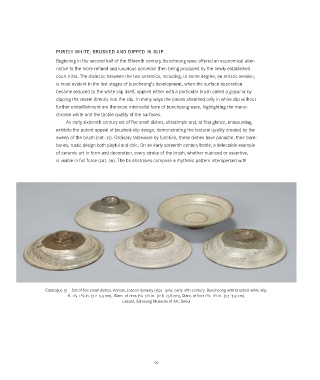Page 77 - Korean Buncheong Ceramics, Samsung Museum Collection (great book)
P. 77
purely WhIte: BruShed and dIpped In SlIp
Beginning in the second half of the fifteenth century, buncheong ware offered an economical alter-
native to the more refined and luxurious porcelain then being produced by the newly established
court kilns. The dialectic between the two ceramics, including, to some degree, an artistic tension,
is most evident in the last stages of buncheong’s development, when the surface decoration
became reduced to the white slip itself, applied either with a particular brush called a guiyal or by
dipping the vessel directly into the slip. In many ways the pieces sheathed only in white slip without
further embellishment are the most minimalist form of buncheong ware, highlighting the mono-
chrome white and the tactile quality of the surfaces.
An early sixteenth-century set of five small dishes, ultrasimple and, at first glance, unassuming,
exhibits the potent appeal of brushed-slip design, demonstrating the textural quality created by the
sweep of the brush (cat. 35). Ordinary tableware by function, these dishes have panache, their bare-
bones, rustic design both playful and chic. On an early sixteenth-century bottle, a delectable example
of ceramic art in form and decoration, every stroke of the brush, whether nuanced or assertive,
is visible in full force (cat. 36). The brushstrokes compose a rhythmic pattern interspersed with
Catalogue 35 Set of five small dishes. Korean, Joseon dynasty (1392–1910); early 16th century. Buncheong with brushed white slip,
1
1
1
3
1
3
H. 1 ⁄4–1 ⁄8 in. (3.2–3.4 cm), Diam. of rims 5 ⁄8–5 ⁄2 in. (12.8–13.8 cm), Diam. of feet 1 ⁄8–1 ⁄2 in. (3.5–3.9 cm).
Leeum, Samsung Museum of Art, Seoul
62

